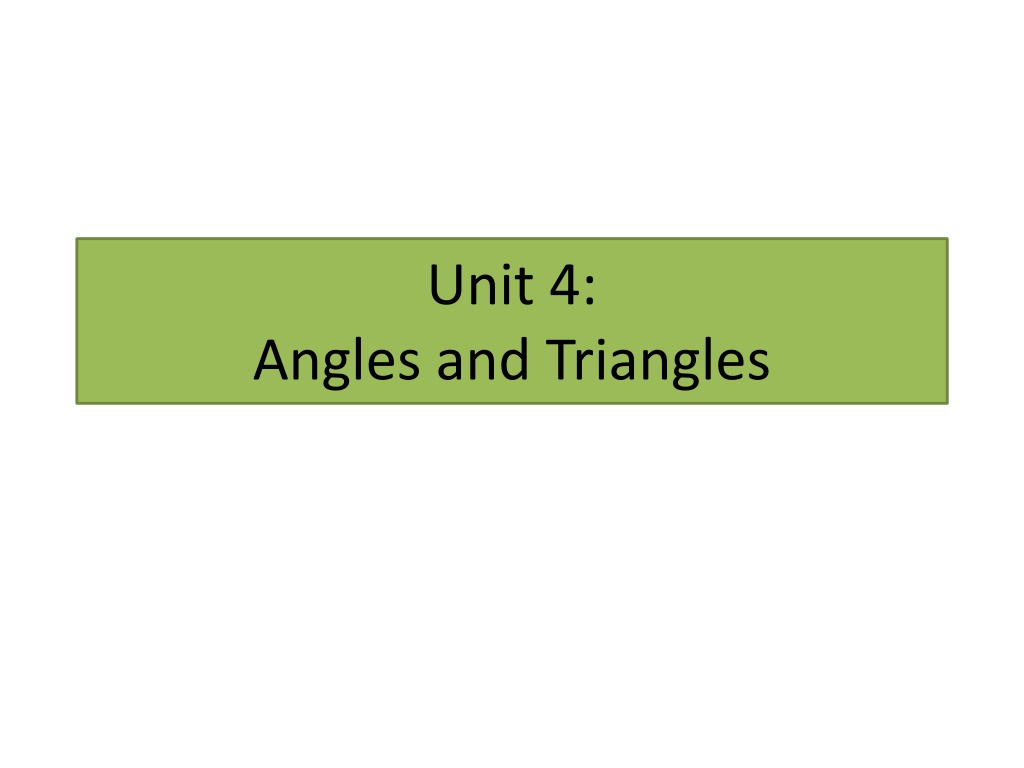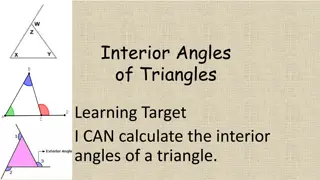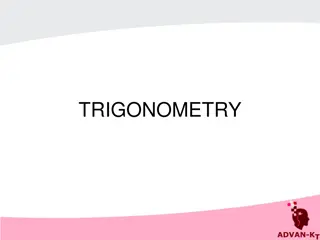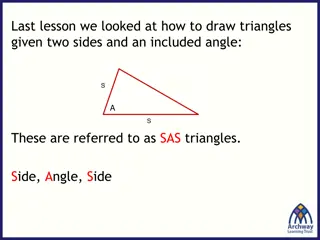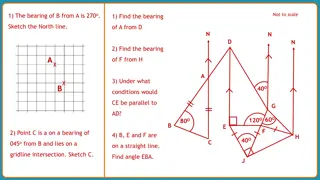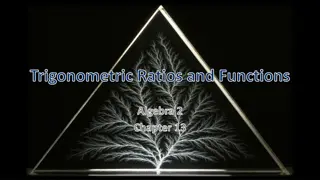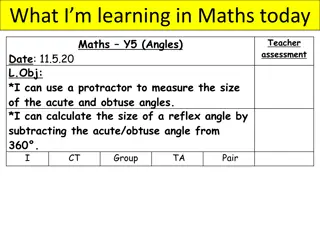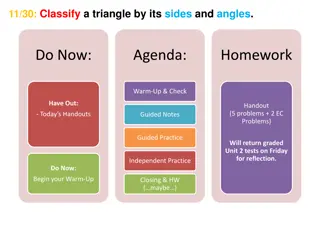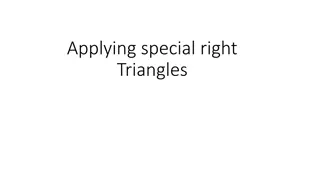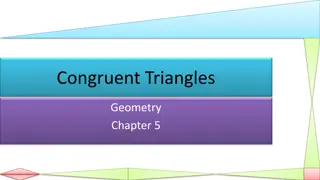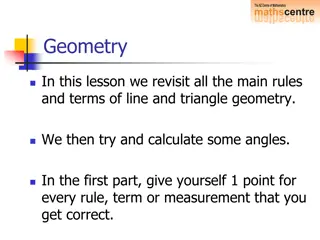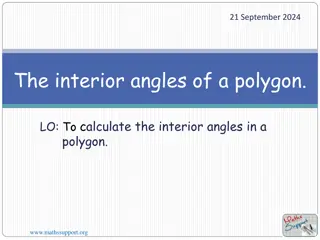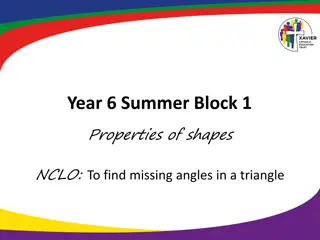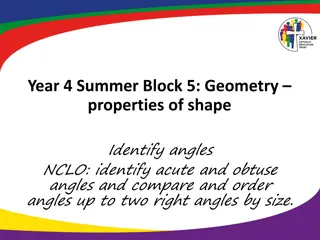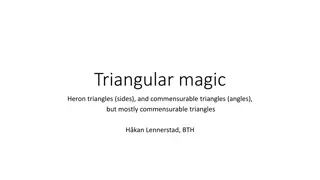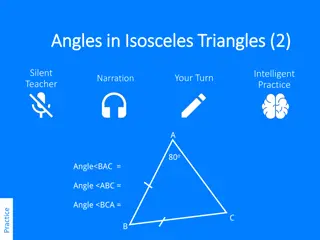Angles and Triangles
Angles, triangles, and the Pythagorean Theorem in geometry. Learn about angle measurements, types of angles, complementary and supplementary angles, and how to find missing sides in triangles using the Pythagorean Theorem.
Uploaded on Feb 16, 2025 | 0 Views
Download Presentation

Please find below an Image/Link to download the presentation.
The content on the website is provided AS IS for your information and personal use only. It may not be sold, licensed, or shared on other websites without obtaining consent from the author.If you encounter any issues during the download, it is possible that the publisher has removed the file from their server.
You are allowed to download the files provided on this website for personal or commercial use, subject to the condition that they are used lawfully. All files are the property of their respective owners.
The content on the website is provided AS IS for your information and personal use only. It may not be sold, licensed, or shared on other websites without obtaining consent from the author.
E N D
Presentation Transcript
Unit 4: Angles and Triangles
Angle Measure Angles are formed when two lines meet or intersect The point at which they intersect is called the vertex of the angle The angle shown can be written as <ABC or <CBA, or simply <B
Angle Measure The size of an angle is measured in degrees One full rotation of a circle is 360o A quarter circle rotation is 90oand the angle formed is called a right angle; the lines that form a right angle are perpendicular A half circle rotation is 180oand is called a straight angle Any angle less than 90ois called an acute angle Any angle greater than 90obut less than 180ois called an obtuse angle
Angle Measure 360o 180o 90o Straight Angle Right angle Acute Angle Obtuse Angle
Angle Measure If two angles add up to 90o, they are said to be complementary 74o 16o If two angles add up to 180o, they are said to be supplementary 30o 150o
Angle Measure If two angles are complementary, and one angle measures 82o, what size is the other angle? If two angles are supplementary, and one angle measures 123o, what size is the other angle?
The Pythagorean Theorem In a right triangle (a triangle with a 90o angle), the side opposite the right angle, which is the longest side of the triangle, is called the hypotenuse The two shorter sides are called the legs The Pythagorean Theorem is a relationship between the three sides of the triangle ?2+ ?2= ?2 In the above equation, a and b are the legs of the triangle, while c is the hypotenuse
The Pythagorean Theorem Find the missing sides of triangle ABC
The Pythagorean Theorem Find the length of side a in triangle ABC (measurements given in cm)
Offsets When two pipes are parallel to each other, they are an offset distance apart They may both be vertical or both be horizontal
Offsets The rise and run of an offset is the same distance For parallel vertical pipes, there is a rise For parallel horizontal pipes, there is a run The diagonal pipe is known as the travel
45o Offsets The most common offset is the 45o offset Use Pythagorean Theorem to determine the formula to find the travel of an offset In a 45o triangle, as shown, the two legs are equal
45o Offsets Using a run of 1 and an offset of 1, you can calculate the travel per foot of offset ?2+ ?2= ?2 12+ 12= ?2 1 + 1 = ?2 2 = ?2 ? = 2 1.414 Therefore, the travel of a 45o offset is 1.414 x offset
45o Offsets A piping offset requires an offset of 300 mm. What is the dimension of the rise and the travel?
45o Offsets The piping offset shown has a travel of 37 . What is the dimension of the offset and run?
22.5o Offsets Use the Pythagorean Theorem to calculate the travel of a 22.5ooffset with an offset of 4.45 and a run of 10.75
22.5o Offsets Use the calculations from the previous question to determine the offset for 22.5o (hint: divide the offset by the run)
22.5o Offsets Find the offset of a 22.5ooffset if the run is 27 Find the run and travel of a 22.5o offset with an offset of 290 mm
Parallel Offsets Equal spread parallel offsets have parallel angles half that of the offset angle If 45o offsets are used, the parallel angle is 22.5o (use this to determine the difference in length between parallel pipes) The distance between the offsets is called the spread In almost all cases, the travel of both offsets is the same
Parallel Offsets To calculate the difference in length between two parallel pipes, use the constant calculated for 22.5o offsets 0.414 x spread = difference in length
Special Case of Parallel Offsets You can use two 45o fittings to make a 90o turn The same offset and parallel angles are used The difference in length is still 0.414 x spread The travels are no longer equal; they differ by two times the difference in length
Rolling Offset Up to now, we have looked at offsets that are either vertical OR horizontal Occasionally, the offset must be both vertical AND horizontal. This is called a rolling offset
Rolling Offset Think of a rolling offset as a pipe that enters one corner of a box and exits through the farthest possible corner from the entry point
Rolling Offset The entire solution of the rolling offset depends upon combining the rise and the offset into a single dimension called the true offset The true offset and the setback become the two sides of the triangle around the travel The true offset (equal to the setback with 45o fittings) is multiplied by the constant 1.414 (for 45o fittings) to determine the travel
